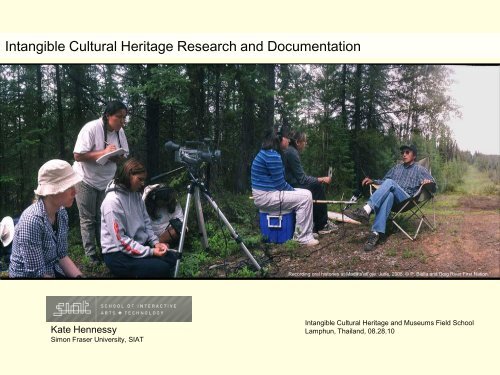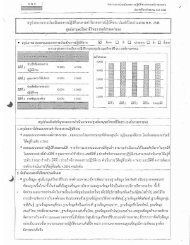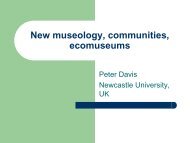Intangible Cultural Heritage Research and Documentation
ICH Research and Documentation(p1-50)
ICH Research and Documentation(p1-50)
- No tags were found...
Create successful ePaper yourself
Turn your PDF publications into a flip-book with our unique Google optimized e-Paper software.
<strong>Intangible</strong> <strong>Cultural</strong> <strong>Heritage</strong> <strong>Research</strong> <strong>and</strong> <strong>Documentation</strong>Recording oral histories at Madátsʼatlʼǫje. June, 2005. © P. Biella <strong>and</strong> Doig River First Nation.Kate HennessySimon Fraser University, SIAT<strong>Intangible</strong> <strong>Cultural</strong> <strong>Heritage</strong> <strong>and</strong> Museums Field SchoolLamphun, Thail<strong>and</strong>, 08.28.10
Some important concepts from our discussions so far:- relationships between tangible, intangible, <strong>and</strong> naturalheritage- Community participation <strong>and</strong> collaboration- Process is as important as product- Keeping ICH from “freezing” through identification <strong>and</strong>inventory…now documentation- Appropriate Museology….now appropriate documentation- Indigenous Curation
How do we keep thefire of ICH burningbrightly?
Sign at Museum of Anthropology. Photo by Kate Hennessy, 2009.
Sign at Museum of Anthropology. Photo by Kate Hennessy, 2009.
What is appropriate?Sign at Museum of Anthropology. Photo by Kate Hennessy, 2009.
What is appropriate?Why or why not?Sign at Museum of Anthropology. Photo by Kate Hennessy, 2009.
Informed Consent
Informed ConsentWhat is appropriate?Consent form?Verbal agreement?Ask your research communityfor the answer.
Digital?
control
Mareno.org@Flickr
El Condor Pasa appropriated a Bolivian folk song…
Protection of <strong>Documentation</strong>vs.Preservation of <strong>Documentation</strong>El Condor Pasa appropriated a Bolivian folk song…
What is most appropriate in your context?
What is most appropriate in your context?“Old” media?“New” media?
Key Questions• Which forms of intangible culturalheritage should be researched<strong>and</strong> documented?• How should communities beinvolved in the process?• What kinds of information aboutintangible cultural heritage shouldbe gathered?• How can documentation reflectlocal diversity of voices <strong>and</strong>perspectives?• How can appropriate forms ofmedia be determined fordocumentation of ICH?• What kinds of permissions shouldbe obtained at the time ofdocumentation?• How might these permissionschange over time?
OverviewPart 1: ICH <strong>Research</strong> <strong>and</strong> <strong>Documentation</strong>• Identify Key Issues• Ask Key Questions• Community Participation in the 2003 ICHC• Case Examples from my research…•Inuvialuit MacFarlane Collection, SmithsonianInstitution•DoBES: <strong>Documentation</strong> of Endangered Languages,Max Planck Institute, Netherl<strong>and</strong>s.•Dane Wajich––Dane-zaa Stories <strong>and</strong> Songs:Dreamers <strong>and</strong> the L<strong>and</strong>: Doig River First Nation
Community Collaboration <strong>and</strong> the 2003 ICH ConventionAccording to Article 11(b), each State Party shall:identify <strong>and</strong> define the various elements of the intangiblecultural heritage present in its territory, with theparticipation of communities, groups, <strong>and</strong> relevant nongovernmentalorganizations (UNESCO 2003b).
Community Collaboration <strong>and</strong> the 2003 ICH ConventionArticle 15, titled Participation of communities, groups <strong>and</strong>individuals states:Within the framework of its safeguarding activities ofthe intangible cultural, heritage, each State Party shallendeavor to ensure the widest possible participation ofcommunities, groups <strong>and</strong>, where appropriate,individuals that create maintain <strong>and</strong> transmit suchheritage, <strong>and</strong> to involve them actively in itsmanagement.
Community Collaboration <strong>and</strong> the 2003 ICH ConventionRichard Kurin (2004):“Taken at its word, this implies that members of the communities whoseheritage is being safeguarded are to be full partners with any <strong>and</strong> allsuch efforts. Governments, or university departments or museums,cannot just assume they have permission to define ICH <strong>and</strong> undertakeits documentation, presentation, protection or preservation. Communityparticipation is meant to be significant <strong>and</strong> meaningful– involving theconsent of community leaders, consultation with lead culturalpractitioners, shared decision-making on strategies <strong>and</strong> tactics ofsafeguarding <strong>and</strong> so on. Article 15 strongly empowers the community inthe operation <strong>and</strong> realization of the Convention” (p. 15).
OverviewPart 1: ICH <strong>Research</strong> <strong>and</strong> <strong>Documentation</strong>• Identify Key Issues• Ask Key Questions• Community Participation in the 2003 ICHC• Case Examples from my research…•Inuvialuit MacFarlane Collection, SmithsonianInstitution•DoBES: <strong>Documentation</strong> of Endangered Languages,Max Planck Institute, Netherl<strong>and</strong>s.•Dane Wajich––Dane-zaa Stories <strong>and</strong> Songs:Dreamers <strong>and</strong> the L<strong>and</strong>: Doig River First Nation
1. <strong>Documentation</strong> of ICH throughaccess to museum collections…Inuvialuit Knowledge Repatriation Project:The Smithsonian MacFarlane Collection© 2009 Kate Hennessy
Inuvialuit Knowledge Repatriation Project: The MacFarlane CollectionCollaboration between Dr. Natasha Lyons, Inuvialuit <strong>Cultural</strong> Resource Centre,Inuvialuit Communications Society, NMNH (Smithsonian), IPinCH Project.- Connecting originating Inuvialuit community members to artifactscollected from their region- To build relationships between community members,researchers, <strong>and</strong> Smithsonian curators- To reconnect intangible cultural knowledge with material culture- To document intangible knowledge- To bring the knowledge back home to the Inuvialuit community
Inuvialuit <strong>Cultural</strong> Resource CentreNational Museum of Natural History,Smithsonian Institution
Conservation “best practices”Photo by Kate Hennessy, 2009.
Touching the objects…Photo by Kate Hennessy, 2009.
Photo by Kate Hennessy, 2009.
“Objects st<strong>and</strong> for significant traditions, ideas,customs, social relations, <strong>and</strong> it is the storiesthey tell, the performance they are a part of,<strong>and</strong> relationships among people <strong>and</strong> betweenpeople <strong>and</strong> places that are more importantthan the objects themselves.”(Kreps 2009:197)Photo by Kate Hennessy, 2009.
Knowledge about objects…Photo by Kate Hennessy, 2009.
Talking about the objects…Photo by Kate Hennessy, 2009.
Documenting knowledge of the objects…Photo by Kate Hennessy, 2009.
Elders <strong>and</strong> youth…Photo by Kate Hennessy, 2009.
<strong>Documentation</strong>: Taking knowledge home…Photo by Kate Hennessy, 2009.
Transmissionof intangible cultural heritagethrough access to museumcollectionsPhoto by Kate Hennessy, 2009.
OverviewPart 1: ICH <strong>Research</strong> <strong>and</strong> <strong>Documentation</strong>• Identify Key Issues• Ask Key Questions• Community Participation in the 2003 ICHC• Case Examples from my research…•Inuvialuit MacFarlane Collection, SmithsonianInstitution•DoBES: <strong>Documentation</strong> of Endangered Languages,Max Planck Institute, Netherl<strong>and</strong>s.•Dane Wajich––Dane-zaa Stories <strong>and</strong> Songs:Dreamers <strong>and</strong> the L<strong>and</strong>: Doig River First Nation
2. <strong>Documentation</strong> of ICH through documentation of endangered languages
DoBES: <strong>Documentation</strong> of Endangered Languages, Max PlanckInstitute, Netherl<strong>and</strong>s- documentation of endangered languages as carriers of intangibleheritage: oral traditions, personal narratives, “traditional” activities<strong>and</strong> cultural practices- <strong>Research</strong>ing language communities <strong>and</strong> determining wholanguage speakers, “knowledge bearers” are- Collecting diverse languages for comparative study- Recording with a variety of media-- photographs, audiorecordings, video recordings, language transcriptions <strong>and</strong>translations- Obtaining consent from speakers at time of documentation- Collecting contextual information about documentation--“metadata”- Archiving documentation at the Max Planck Institute; multiplecopies; intensive attention to ensuring the persistence of thearchive
Endangered languages as world heritage…
<strong>Documentation</strong> of ICH archived for comparative study, salvaged in advance of extinction
OverviewPart 1: ICH <strong>Research</strong> <strong>and</strong> <strong>Documentation</strong>• Identify Key Issues• Ask Key Questions• Community Participation in the 2003 ICHC• Case Examples from my research…•Inuvialuit MacFarlane Collection, SmithsonianInstitution•DoBES: <strong>Documentation</strong> of Endangered Languages,Max Planck Institute, Netherl<strong>and</strong>s.•Dane Wajich––Dane-zaa Stories <strong>and</strong> Songs:Dreamers <strong>and</strong> the L<strong>and</strong>: Doig River First Nation







